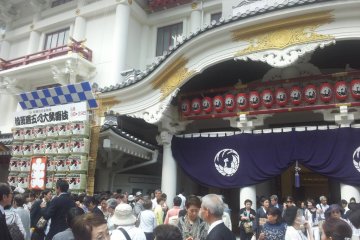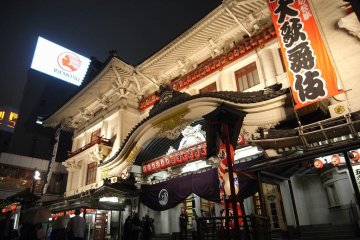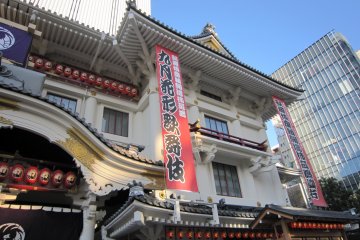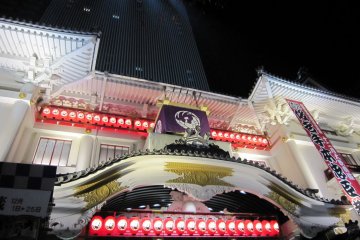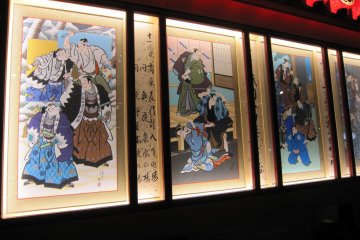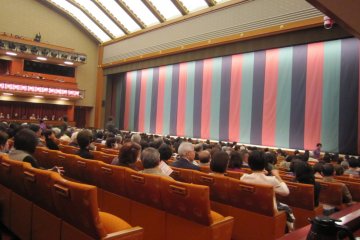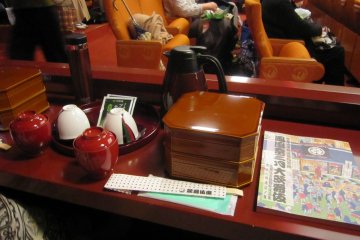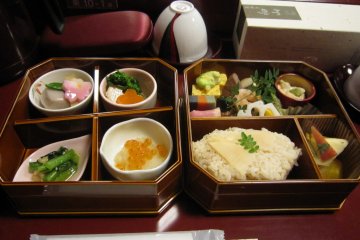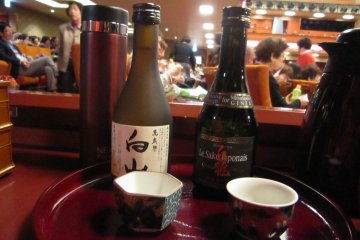I went to see Kabuki the other day at the Kabuki-za in Ginza. As a fan of Kabuki, watching it at a theater is usually not a big thing for me, but this time was quite different, as I watched it from a box seat on the 1st floor of the newly-renovated Kabuki-za for the first time in my life.
Box seats at Kabuki-za are special seats where you can enjoy watching Kabuki plays while drinking & eating. However, it wasn't that special in Edo Era, when the audience sat on a tatami-mat floor with their food spread out in front of them, and enjoyed the 'picnic' while watching Kabuki. The current box seats at Kabuki-za came from that tradition and they are nothing special other than that the price of the seat is (only) 2,000 yen higher than a regular first class seat ticket.
You may wonder why everyone wouldn't want to sit in a box seat if the price is not that different. Actually, the number of box seats is limited and it's hard to get one. However, Kabuki-za is the only theater in Japan where only Kabuki is performed throughout the year from the 1st to the 25th of every month, and if your schedule is flexible, the box seats might be available on some days.
There are 40 box seats (20 on both sides) on the 1F, and 44 box seats (22 on both sides) on the 2F. On the 2nd floor, there are only tables in the box seats; food is not served. You must bring your own. But you don't have to gulp down your food in a hurry during one of the short breaks. You can take your time eating & drinking while watching the play and the price is the same as for a regular first class ticket. To the box seats on the 1st floor, the lunch/dinner you ordered in advance will be served just before the first intermission of 30 min. begins. Of course you can bring in your own food if you prefer.
We ordered some special box seat bento luncboxes in advance. You don't want to spoil the experience by bringing in some bento boxes bought at a convenience store, do you? We also brought in two small bottles of sake and sake cups. Drinking sake while watching kabuki is what we should do in a circumstance like this, right? It happened that one of the plays that night was Kanjincho, in which there was a scene where the character Benkei, drinks sake from an enormous Japanese lacquered tray. We waited for Benkei to start drinking, and just as he started to drink we made a toast to him on the stage, and drank. You can surely imagine how happy we were! As far as I could tell, we were the only ones who brought in sake and drank with Benkei that night. Considering how special the experience was, the extra price was well worth it!
The New Kabuki-za, which re-opened in April last year after the 3-year renovation, is the 5th Kabuki-za in its history. It doesn't look so different from the 4th one, except for the gigantic office building called Kabuki-za Tower which was built behind it. When compared to the 4th Kabuki-za in detail however, the number of western-style restrooms has increased, escalators were installed, and direct access from the subway was established; all in all it's more convenient and customer-friendly than it was before. There is the 'Kabukiza Gallery' on the 5th floor of the Kabukiza Tower where you can see Kabuki costumes, etc. It opens from 10AM to 6PM (last admission at 5:30), and the fees are 600 yen/adult, 500 yen for elementary/high-school students, free for children younger than elementary school. There's also a free roof garden where you can see the stone lantern of Kawatake Mokuami.
Generally, Kabuki is considered to be something lofty but I must say that this conception is totally wrong. The style is classic, yes, and the lines are a little bit difficult to understand, but other than that it's not so much different from regular period plays. In the Edo Era, Kabuki was the style favored by the general public, easy to watch and enjoy. High-ranked people like lords and samurai favored Noh instead. The stories of Kabuki plays have been the same for centuries, just as those in Classical plays, Opera, Ballet, etc. have been. If you read the story before the play begins, you can understand what's going on on the stage fairly easily. To help those who don't like studying stories before the performance, an Audio guide (700 yen, with deposit of 1,000 yen) is available in both Japanese/English. There is also a Visual guide with subtitles (1,000 yen/each, no deposit) available at the theater.
Kabuki-za is a place where large numbers of tourist buses arrive day and night, day in and day out. They want to see Kabuki, one of the traditional Japanese performing arts with over a 400 year history, once in their lifetime. And I'd highly recommend you too watch it once in your lifetime at the newly renovated Kabuki-za in Ginza, Tokyo. The price of tickets varies from 4,000 yen (3rd floor) to 20,000 yen (1st floor box seats) and it may change slightly each month depending on who is performing what roles. And there is good news for those who don't want to spend too much money yet want to get a taste of what Kabuki is like. The Kabuki-za provides a One-Scene Seat (see PDF link), with which you see only one scene out of several plays. The seats are on the 4th floor, in the top gallery, and the fee is only 2,000 yen. The tickets are only sold on the day of the performance, so you have to stand in a long line. But if you happen to have time to spare and nothing to do, just dropping by the Kabuki-za nonchalantly and watching one scene of Kabuki IS the true spirit of Tokyoite, isn't it? You can buy tickets at the Shochiku Homepage. More photos of this famous theater can be seen at another photo story of Japan Travel.



